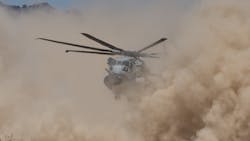Collins to provide night-vision helmet-mounted display for air crews flying in degraded visual conditions
PATUXENT RIVER NAS, Md. – U.S. Navy vertical-lift aviation experts needed a helmet-mounted display with night-vision capability that can generate symbols and imagery, and integrate with existing helicopters and tiltrotor aircraft. They found their solution from Collins Aerospace in Cedar Rapids, Iowa.
Officials of the Naval Air Warfare Center Aircraft Division at Patuxent River Naval Air Station, Md., announced a $24.7 million contract to Collins Aerospace last week for full-scale development of the Enhanced Visual Acuity (EVA) system.
The EVA will replace the current family of AN/AVS-9 night-vision goggles and helmet-mounted displays on helicopters and tiltrotor aircraft, and will improve on the capabilities of the AN/AVS-9.
EVA is to increase flight safety and mission effectiveness by enabling Navy and Marine Corps helicopter and tiltrotor aircraft crews maintain visual situational awareness down to very low altitudes during the day and at night -- especially in degraded visual conditions like blowing dust and snow.
Related: Army looking for electro-optics companies to build 10,000 drivers night vision systems
The EVA system also will provide a heads-up display for pilot and co-pilot viewing of aircraft-generated video that is relevant to their missions.
For flight crew members who do not need flight helmets, the EVA will provide a helmet-mounted night-vision goggle with enhanced night vision capability to help crew members do their jobs in degraded visual environments.
The system will display enhanced night scene, video, and symbology, and offer night-vision performance at least as good as the L-3 Technologies ANVIS-9 night-vision goggles that are deployed today.
The new EVA system will have no image artifacts to degrade aircrew's ability to perceive night scenes accurately, and offer a field of view of at least 40 degrees horizontal and vertical, and as wide as 110 degrees horizontal and 60 degrees vertical.
Blooming and haloing effects around light sources will be less than seen in current ANVIS-9 night-vision goggles, and the display will be able to present color images during the day and at night. Mean time between failures will be greater than 350 hours.
The EVA system will be interoperable with currently fielded aircraft, with minimal modifications necessary to existing equipment.
On this contract Collins Aerospace will do the work in Cedar Rapids, Iowa; Santa Clara and Los Gatos, Calif.; and Westborough, Mass., and should be finished in March 2023.
For more information contact Collins Aerospace online at www.rockwellcollins.com.
